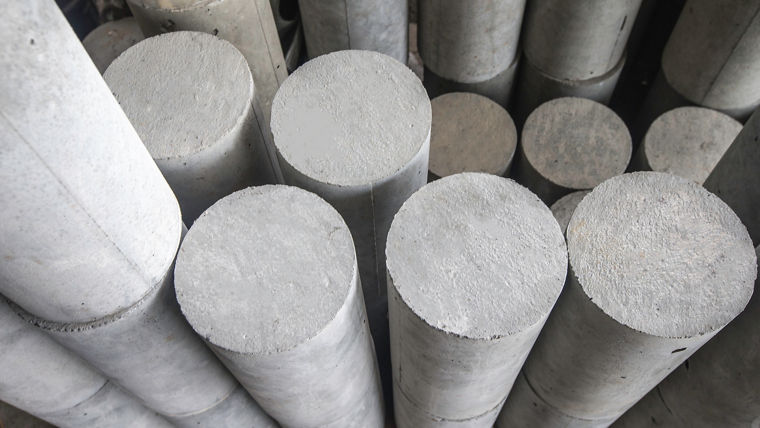When the chemist Dr. Anke Reinschmidt is explaining the special power of WallCraft, she asks visitors to stand very close to the concrete block that is dangling from a rope in the remotest corner of her laboratory in Essen. Only then can they see the thin white line that runs through the block.
“Here you can see the place where the test piece was broken and has now bonded together again,” she explains. To demonstrate how firmly the crack has been mended, her team has suspended a pail of sand from the concrete block. The word “mended” is actually misleading. Special bacteria that had been added to the raw concrete have sealed the crack on their own through their metabolic reaction, without any human assistance.

The formulation of the additive called WallCraft comes from Evonik and is set to be launched on the market soon. “This additive combines traditional construction chemistry with cutting-edge biotechnology,” says Reinschmidt, the technical director of application technology and the technical service for construction at Evonik. The bacteria in the brown powder can be easily mixed into mortar or cement. For the microbes, this environment is so alien that they remain in their spore state. Theoretically, this type of hibernation could enable them to survive forever. Only if water seeps into the concrete—for example, through a fine stress crack in a structural element—do the microbes revive and start producing calcium carbonate, or limestone, through their metabolic process. The limestone seals the crack automatically, the water source dries up, and the bacteria go back into hibernation—until the next case of water damage.
Evonik is not the only company that has set great hopes on this development. After all, enabling concrete buildings to repair themselves and thus substantially lengthen their useful life is an important step in economic and environmental terms. But the problem is much bigger than the tiny bacteria. It begins with the vast demand for fresh concrete. Both concrete and cement, which is one of its main components, are everywhere, and the global demand for them grows every year. At last count, the annual demand was more than four billion tons.
ELEMENTS-Newsletter
Receive exciting insights into Evonik's research and its social relevance - conveniently by e-mail
Concrete—a construction material that’s thousands of years old
n past ages, concrete must have seemed almost magical. It’s a man-made stone that starts out as a liquid but hardens into a solid that lasts forever. Human beings were already using materials similar to concrete 14,000 years ago. The Pantheon in Rome is not the oldest example, but it’s one of the most impressive. The overarching dome, which is made of Roman concrete (opus caementitium in Latin), has a span of more than 40 meters. It still astonishes visitors today, almost 1,900 years after it was built. In the 19th century the type of concrete we know today finally began its triumphal march—in buildings, bridges, tunnels, and road surfaces. About 30 billion tons of concrete are used for construction every year, about half of it in China. Today China produces and uses more concrete in two years than the USA has produced and used in the entire 20th century. Other emerging economies are catching up and boosting the global demand even more. “Concrete has been a major contributor to lifting many millions of people out of poverty,” says Dr. Karen Scrivener, a materials scientist who heads the laboratory for construction materials at the Ecole Polytechnique Fédérale de Lausanne. “And we need to continue this because people need a chance to lead a dignified life.”

However, the negative effect of this building material on the environmental balance is increasingly ruining its image. That’s why concrete needs to reinvent itself in order to join the movement toward sustainable construction. Construction chemistry is playing a huge role in this effort. The aim is not only to make this material even stronger, which was the previous goal, but also to make it more environmentally and climate-friendly.
STEALING SAND FROM BEACHES
The biggest defect of concrete is due primarily to cement. This binder is mixed with water and aggregates such as sand or gravel to make concrete. Cement production releases huge amounts of carbon dioxide. The cement industry alone is responsible for eight percent of man-made global CO2 emissions. The effect on the climate varies widely, depending on the type of cement production. In Germany, cement production releases 590 kilograms of CO2 per ton of cement on average, but in other countries that figure is much higher. The main culprit in this situation is clinker, the main component of every type of cement. Clinker is basically heated limestone. The ground limestone is heated to 1,450°C. In addition to the huge amount of energy that is needed for this process, the chemical reaction that takes place during the burning generates large amounts of greenhouse gas emissions. When calcium carbonate (CaCO3 ) is converted into calcium oxide (CaO), CO2 remains. That’s an unalterable natural law.

In order to reduce carbon dioxide emissions, some researchers are looking for ways to replace clinker with other materials such as ground slag from the blast furnaces that are used to produce pig iron, fly ash from the exhaust gas filters of coal-fired power plants, or various types of natural stone.
Whereas traditional Portland cement consists of 95 percent clinker, all the types of cement used in the EU contain just under 74 percent clinker on average. The International Energy Agency (IEA) predicts that the percentage of clinker in cement will continue to decrease toward 60 percent in the years ahead. Newly developed formulations are already reducing this proportion to less than 50 per cent with the help of climate-friendly substitutes.
But the world’s ever-growing hunger for concrete also brings other risks besides the emission of climatedestroying gases. It also devours large quantities of resources—especially sand, water, steel, and energy.
Because desert sand, which has been worn smooth, is not suitable for concrete production, the illegal removal of sand from riverbeds and beaches is growing. “The quality of the sands that are used is getting worse and worse,” says Reinschmidt. In order to mix high-quality concrete in spite of this problem, producers need the right additives. The recycling of concrete can also help producers use less cement and greenhouse gases. Here too, additives can help construction materials maintain their customary level of performance.

SOLUTIONS FOR A CONSERVATIVE SECTOR
We solve problems. That’s what we’ve always done,” says Reinschmidt. She has dedicated her research career to concrete additives. This was the topic of her doctoral thesis 20 years ago. After a series of jobs in the USA and South America, she started working at the Evonik laboratory in Essen. Here Evonik is testing many different additives that improve concrete. For example, superplasticizers combined with defoamers from Evonik make it possible to use less water in the mix. That makes the concrete harder, yet capable of being pumped up to the top floor of the highest skyscraper. Shrinkage reducers minimize concrete components’ tendency to deform or crack as they harden. Air-entraining agents ensure that air bubbles are distributed throughout the concrete in exactly the right sizes and amounts. “If there’s too much or too little air in the concrete, or if it’s unequally distributed, the structural element is damaged,” says Reinschmidt. And hydrophobing agents prevent water from penetrating the hardened material. Thus they help to protect buildings from the effects of the weather and make them more durable. In the future, the bacteria in WallCraft will have the same effects—but these effects will be more active and last longer. “Especially in new construction projects, we have the opportunity to reduce emissions over the long term by using longer-lasting concrete,” explains Magnus Kloster.
He’s the head of the market segment for the construction industry at Evonik’s Interface & Performance business line. Before joining Evonik, he worked for a long time at a leading supplier for the concrete construction sector. “If highway bridges last for 60 years instead of 50, for example, that saves tremendous amounts of material and CO2 emissions over the long term,” he explains. Selfhealing concrete, he adds, has what it takes to significantly reduce the amount of construction material that is used. “That’s especially true for emerging and developing countries, where concrete recycling is sometimes not even economically feasible, partly because they do a lot of their construction from scratch,” says Kloster.


WallCraft shows how this works. Reinschmidt and her team have tested this phenomenon countless times. Boxes full of tiny test pieces, which are known here as prisms, are stacked up in every available corner of the lab. New prisms are being produced just now, using standardized sand in standardized metal molds measuring four centimeters by four centimeters by 16 centimeters. The room temperature is a standardized 23°C, and the humidity is kept at a constant 50 percent. “In the construction sector, nothing stays unstandardized,” says Reinschmidt. Reliability is all-important. The prisms are tested to find out how quickly, how strongly, and how often the material grows together again at different moisture contents, for example. “We also investigate how compatible the product is with other additives and with every kind of formulation,” Reinschmidt explains. Each new material has to function reliably. The construction sector tries to avoid experimentation, because if concrete structures crumble the producers and processors of the concrete may be hit by claims for compensation.

More extensive and even more impressive tests are being conducted on the other side of the city. This is where Wissbau, a spinoff company of the University of Duisburg-Essen, tests construction materials in its capacity as an independent appraiser. The test lab is located in an extensively restructured 18th-century farmhouse.
Last year Wissbau was commissioned by Evonik to pour a number of huge concrete troughs. Since then, the lab workers have regularly used brute force to make cracks in the troughs in a controlled way. The troughs, now damaged by fine cracks, are filled with water, which gradually seeps through the cracks. Within a month, the bacteria seal the cracks, no more water seeps out, and the outer concrete wall dries out again.
“Cracks of this kind appear in concrete again and again, either because of the hardening process or later on due to stress,” Reinschmidt explains. However, she adds, that in itself is not really a problem. Only if water is constantly penetrating the concrete, causing the reinforcing steel to rust, or expanding during freezing weather is the structural element permanently weakened and ultimately destroyed. “A concrete that automatically seals its own cracks protects itself from serious damage,” she adds.


REFILLING INSTEAD OF DEMOLITION
The concept of a self-healing concrete has been circulating in the sector for quite a while. In fact, conventional concrete also has the ability to seal small cracks on its own. However, in most cases this process takes much too long. Researchers at the Technical University of Munich have been experimenting for some time now with fine glass capillaries that are filled with liquid plastic and embedded in concrete. When the capillaries break because of movements within the concrete, the plastic runs out and glues together any cracks that have formed. Several research teams are also studying bacteria—for example, teams at Delft University of Technology in the Netherlands and Ghent University in Belgium, which have created spinoff companies for this purpose. At Evonik, this concept emerged during an in-house idea competition in 2016. The breakthrough came as a result of networking by construction chemists in Essen and biotechnologists in Halle-Künsebeck, where Evonik operates its biggest biotechnology lab.

Three other labs are located in Marl, Hanau, and Shanghai. The group recently reorganized and consolidated all of its biotechnology expertise. These researchers are working on a wide spectrum of topics, ranging from fermentation processes for cosmetic raw materials to synbiotics for gut health.
For WallCraft, the biotechnologists first searched their microbe library for an organism that was suitable for concrete. They found a strain they themselves had previously isolated in an environmental sample. “We were very familiar with its DNA and its characteristics,” says Lukas Falke, the head of this project in Halle-Künsebeck.

MICROBES REPLACE MANUAL WORK
The selected strain of Bacillus subtilis is an especially tough representative of the hay bacteria group. These bacteria exist almost everywhere, and they thrive just as well in the soil as in the human gut. However, concrete is an inhospitable environment for these microorganisms. Cement is alkaline, and as it hardens it develops temperatures over 60°C. However, the WallCraft bacterium is not too bothered by either the heat, the hostile pH value or the spiky crystals in hardened concrete.
Besides, when it comes into contact with water it quickly begins to metabolize the sources of carbon provided. Evonik equips the microbes with the provisions they need, right from the start. The precise composition of this nutrient is a well-kept secret. “In addition to the bacterial strain, for which we have registered a patent, the nutrient formulation is our most important trade secret,” says Falke. The only thing he’s willing to reveal is that sugar, the favorite food of many bacteria, is not part of it. Sugar would be poison for every kind of concrete, because it disrupts the hardening process.

In the small town of Gaggenau near Baden-Baden, Evonik found the first adventurous partner company that was willing to test WallCraft in practice. Here the Grötz company produces prefab garages made of concrete, which are delivered to customers by truck. Fewer concrete cracks in the concrete are a good selling point for the company, especially because a practical test has shown that WallCraft also reduces the formation of flaws in the. Such flaws occur at the surface and in the corners of the formwork as the concrete is hardening, and they subsequently have to be filled in with a trowel. Because this laborious manual work is now no longer needed, the use of WallCraft already pays off when pouring the concrete.
Plans call for this material with its microbes to be used in the future all over the world, not only in garages but also in apartment blocks, bridges, dams and beyond. That could greatly help concrete, the universal construction material, to go on having a bright future.

Protective shield for buildings
Protectosil® protects concrete and other mineral substrates from environmental impacts
The Louvre in Paris, the Sydney Opera House, and Times Square in New York—at many impressive locations, Evonik’s silane-based building protection agents are helping to preserve prominent architecture. Under the brand name Protectosil®, the specialty chemicals group from Essen sells coatings and impregnation agents that protect concrete and plaster as well as natural stone such as sandstone and granite from environmental impacts and vandalism. The active ingredients here are organosilanes—compounds of hydrogen, carbon, and silicon—that the company produces at several locations around the world. Evonik operates a special competence center for silanes in Rheinfelden, close to the German-Swiss border. These multifaceted materials are used in diverse industrial sectors, ranging from semiconductor production to the manufacture of fuel-saving tires. The silanes, which protect the fabric of the building, deeply penetrate the stone. There they form a colorless and breathable impregnation layer that lets air and water vapor escape freely but prevents moisture and pollutants from entering. It also effectively protects the stone from soiling and even from attacks by graffiti sprayers. For example, Protectosil® products protect reinforced concrete from chloride-induced corrosion, a major cause of damage that requires bridges to be renovated over the years. These products can be directly used during the construction phase. A case in point is the bridge across Hangzhou Bay in eastern China—one of the longest transoceanic bridges in the world. Because silane impregnation agents can be applied subsequently without any problems, they are also frequently used for the renovation of existing structures.




